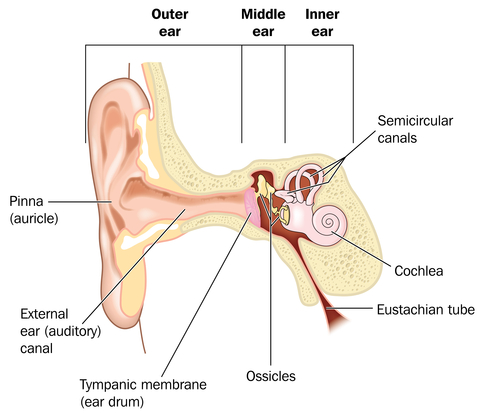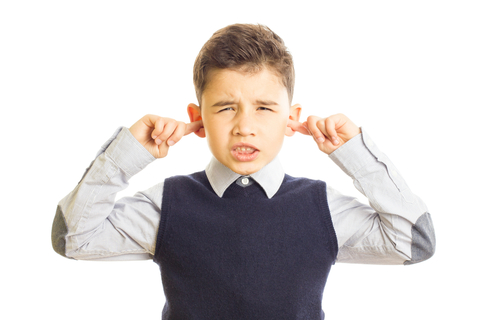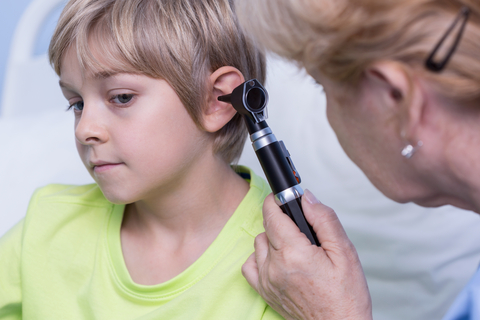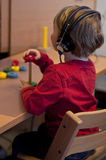About glue ear
Glue ear (medical term: otitis media with effusion) is a condition where there is a build-up of fluid in the middle ear (the part of the ear just behind the eardrum).
The middle ear is normally filled with air which allows the eardrum and small ear bones to vibrate in response to sound. In glue ear, the middle ear fills with fluid which reduces the sound vibrations and hearing can be affected.
Dr Ian Williamson, GP and researcher at University of Southampton talks about the causes of glue ear and the effect it can have on children (2 mins)
To move on through the website, please use the links below. Next section: What causes glue ear?
What causes glue ear?
The build-up of sticky fluid in the middle ear can be caused by a problem with a part of the body called the Eustachian tube.
The Eustachian tube is a thin channel which connects the middle ear with the back of the nose. Most of the time this tube is closed, but when you swallow or yawn, the tube opens to let the air in and any fluid drain out..
Diagram of the ear:

In children with glue ear:
The Eustachian tube can become blocked with mucus, often after a recent cold or ear infection. This stops air entering the middle ear and fluid draining out.
Young children have narrow and horizontal Eustachian tubes which means they can often get blocked.
As children get older, the Eustachain tubes become wider and more upright which allows fluid to drain better. This is why children often grow out of glue ear.
What are the symptoms?
Most common symptoms:
Hearing loss: When children have glue ear their hearing levels can be similar to wearing ear plugs or putting fingers in their ears.
Common symptoms of glue ear include:
- Often mishearing what is said, especially in noisy environments
- Needing the television volume turned up
- Saying ‘eh what’ or ‘pardon’ a lot
- Appearing to lip-read.
Physical ill health: children with glue ear can show symptoms of physical ill-health such as:
- Repeated ear infections (glue ear often follows acute ear infections, colds and flu)
- Snoring, blocked nose or poor sleep
- Noises in the ear or dizziness
- Clumsiness or off-balance.
Long term or persistent glue ear:
If glue ear has been present for a long while you may notice some of the following symptoms:
- Children with glue ear can become frustrated, feel left out and become quiet and withdrawn.
- You may notice that your child is not doing so well at school as expected.
- Your child’s speech and language may appear to be behind other children of similar age.
These symptoms are less common as glue ear normally gets better in 3 months without any treatment. However, if you are particularly concerned about your child's behaviour, educational or speech/language development you can contact your child's GP or health care provider at any time.

How common is glue ear?
Glue ear is extremely common, especially in children aged between 1 and 6 years, although it can develop at any age.
- One in five children will be affected by glue ear in the first year of primary school and 80% of children will have at least one episode by the age of 10 years old.
Children can have glue ear in one or both ears.
- 40% of children with glue ear will have it in both ears.
Glue ear is just as common in boys as in girls.
It is more common in the winter months when there are lots of coughs and colds.

Can glue ear be prevented?
Doctors aren't exactly sure what causes glue ear so there is no way to prevent it in the majority of cases.
However, children often develop glue ear after a cold or an ear infection so there are a number of steps you can take to try and reduce the risk of children getting glue ear:
- Smoke-free environment: Children who live in a smokey environment are more likely to get ear infections and glue ear. Try to make sure that your child's environment is kept smoke-free.
- Childhood vaccinations: It is likely that childhood vaccines will reduce the number of ear infections that children get. Keeping your child's vaccinations up to date may help to prevent glue ear (click here for childhood vaccination schedule).
- Frequent handwashing can be helpful to prevent the spread of viral infections in families. Remind your child to wash their hands regularly, especially before eating and after school.

How is glue ear diagnosed?
Medical history
Your child's medical history helps the doctor, nurse or audiologist (hearing specialist) to diagnose glue ear. In particular they are interested in certain symptoms which can indicate hearing problems:
- Recent research found that children who mishear, turn the TV volume up loud and report any ear-related problem in the previous 3 months are more likely to have glue ear.
Common tests for glue ear include:
Otoscopy is a procedure where your child’s doctor, nurse or audiologist looks into your child’s ear using a medical device called an otoscope to see the ear canal and eardrum. In children with glue ear, the eardrum can look cloudy, be pulled back into the middle ear and sometimes bubbles and fluid can be seen behind the eardrum.

Tympanometry is a simple test for fluid in the middle ear. The tympanometer measures the movement of the eardrum to a change in air pressure. The eardrum moves freely when the pressure inside and outside the ear is the same. When there is fluid in the middle ear, the eardrum does not move so well and sound waves bounce back rather than pass through to the middle ear. The test only takes a few seconds and doesn't cause any discomfort.
Audiometry is a test of hearing levels and is normally carried out by an audiologist (hearing specialist). There are different tests depending on the age of your child.
- Play audiometry is designed for children between 2-5 years and uses games, such as placing a block in a basket or ring on a cone, when they hear a sound. This makes testing fun and engaging for children. Children will wear headphones and the audiologist will test their hearing over a range of sounds and frequencies.
- Visual reinforcement audiometry is a test for very young children who are too young for play audiometry (designed for children aged 6 months to 2-3 years). The test uses visual reinforcement such as video animations or lighted toys placed to each side of the child and children are trained to look at the stimulus when they hear a sound. Children will often sit on a parent’s/carer’s lap and may wear lightweight earphones whilst taking the test.
- Pure-tone audiometry is a test for older children and adults. A range of sounds are played through headphones and patients respond by pressing a button.
